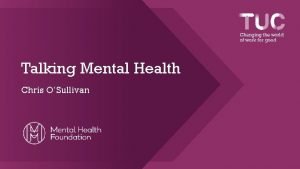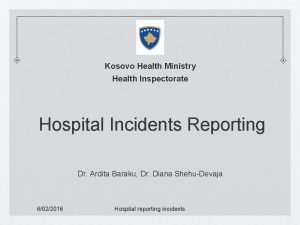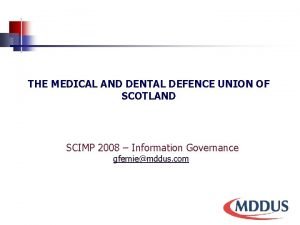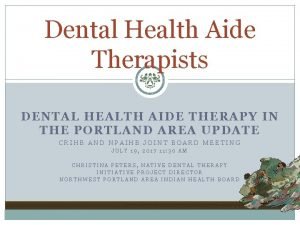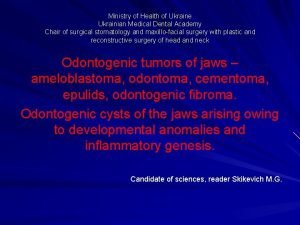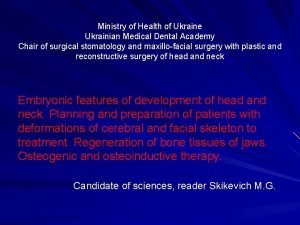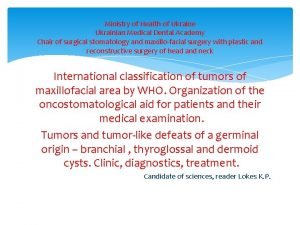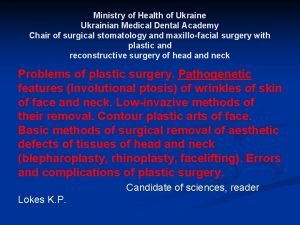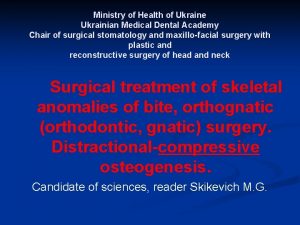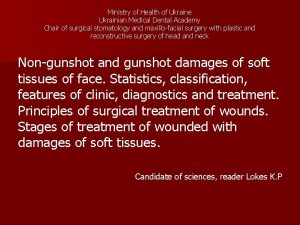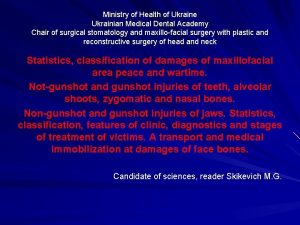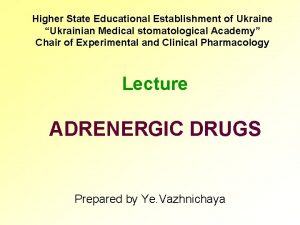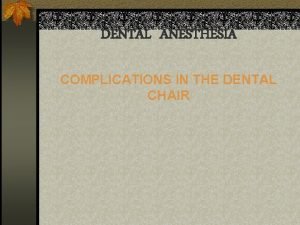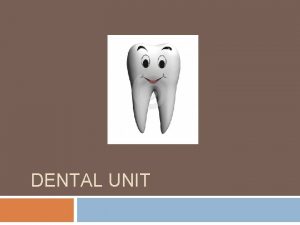Ministry of Health of Ukraine Ukrainian Medical Dental





















































- Slides: 53

Ministry of Health of Ukraine Ukrainian Medical Dental Academy Chair of surgical stomatology and maxillo-facial surgery with plastic and reconstructive surgery of head and neck Paralysis of mimic musculature, atrophy of face. Symptoms and syndromes at plastic and reconstructive surgery. Bases of cranio-maxillo-facial surgery. Candidate of sciences, reader Skikevich M. G.

Lecture plan 1. Paralysis of mimic musculature, atrophy of 2. 3. 4. 5. face. Causes of muscle disorders. Signs and symptoms (MD) Symptoms and syndromes at plastic and reconstructive surgery. Bases of cranio-maxillo-facial surgery.

Paralysis of mimic musculature, atrophy of face. Symptoms and syndromes of plastic and reconstructive surgery. Bases of cranio-maxillo-facial surgery. Muscle Disorders аlso called: Myopathy Your muscles help you move and help your body work. Different types of muscles have different jobs. There are many problems that can affect muscles. Muscle disorders can cause weakness, pain or even paralysis.

Causes of muscle disorders include Injury or overuse, such as sprains or strains, cramps or tendinitis A genetic disorder, such as muscular dystrophy Some cancers Inflammation, such as myositis Diseases of nerves that affect muscles Infections Certain medicines. Sometimes the cause is not known.

Diagnosis/Symptoms – Electromyography (EMG) – MRI of the Musculoskeletal System – Needle Biopsy

atrophy /at·ro·phy/ (at´ro-fe) 1. a wasting away; a diminution in the size of a cell, tissue, organ, or part. 2. to undergo or cause atrophy.

Atrophy is the general physiological process of reabsorption and breakdown of tissues, involving apoptosis on a cellular level. When it occurs as a result of disease or loss of trophic support due to other disease, it is termed pathological atrophy, although it can be a part of normal body development and homeostasis as well.

Facial muscle One of the 43 muscles in the human face. The facial muscles convey basic human emotions such as anger, sadness, fear, surprise, disgust, contempt and happiness by very clear facial signals.

The facial muscles include: Occipitofrontalis muscle Temporoparietalis muscle Procerus muscle Nasalis muscle Depressor septi nasi muscle Orbicularis oculi muscle Corrugator supercilii muscle Depressor supercilii muscle Auricular muscles (anterior, superior and posterior) Orbicularis oris muscle Depressor anguli oris muscle Risorius Zygomaticus major muscle Zygomaticus minor muscle Levator labii superioris alaeque nasi muscle Depressor labii inferioris muscle Levator anguli oris Buccinator muscle Mentalis The platysma is innervated by the facial nerve. Although it is mostly in the neck and can be grouped with the neck muscles by location, it can be considered a muscle of facial expression due to its common innervation. The stylohyoid muscle, stapedius and posterior belly of the digastric muscle are also innervated by the facial nerve, but are not considered muscles of facial expression.

The 11 -year-old girl with discrete facial palsy and mild facial atrophy of the left frontoparietal area.

The 23 -year-old woman with facial palsy, complete ptosis, and improvement of facial asymmetry. Note the deep subcutaneous cleft above the right eyebrow and almost complete loss of the left eyebrow.

The 16 -year-old girl with facial palsy, complete ptosis, and marked atrophy of subcutaneous and bony structures on the left upper side of the face before surgical intervention. Note the slight cleft above the right eyebrow and rarefication of the left eyebrow.

Muscular dystrophy Definition Muscular dystrophy is the name for a group of inherited disorders in which strength and muscle bulk gradually decline. Nine types of muscular dystrophies are generally recognized.

Muscular dystrophy (MD) is a group of more than 30 inherited diseases. They all cause muscle weakness and muscle loss. Some forms of MD appear in infancy or childhood. Others may not appear until middle age or later. The different types can vary in whom they affect, which muscles they affect, and what the symptoms are. All forms of MD grow worse as the person's muscles get weaker. Most people with MD eventually lose the ability to walk. There is no cure for muscular dystrophy. Treatments can help with the symptoms and prevent complications. They include physical and speech therapy, orthopedic devices, surgery, and medications. Some people with MD have mild cases that worsen slowly. Others cases are disabling and severe.

Signs and symptoms (MD) Progressive muscular wasting Poor balance Drooping eyelids. Atrophy Scoliosis (curvature of the spine and the back) Inability to walk Frequent falls Waddling gait Calf deformation. Limited range of movement Respiratory difficulty Joint contractures Cardiomyopathy. Arrhythmias Muscle spasms

The muscular dystrophies include: Duchenne muscular dystrophy (DMD), which affects young boys, causing progressive muscle weakness, usually beginning in the legs. It is the most severe form of muscular dystrophy. Becker muscular dystrophy (BMD), which affects older boys and young men, following a milder course than DMD Emery-Dreifuss muscular dystrophy (EDMD), which affects young boys, causing contractures and weakness in the calves, weakness in the shoulders and upper arms, and problems in the way electrical impulses travel through the heart to make it beat (heart conduction defects). Female carriers of EDMD are at risk for heart block.

Limb-girdle muscular dystrophy (LGMD), which begins in late childhood to early adulthood and affects both men and women, causing weakness in the muscles around the hips and shoulders. It is the most variable of the muscular dystrophies, and there as of 2004 several different forms of the disease recognized. Many people with suspected LGMD have probably been misdiagnosed in the past; therefore, the prevalence of the disease is difficult to estimate. Facioscapulohumeral muscular dystrophy (FSH), also known as Landouzy-Dejerine disease, which begins in late childhood to early adulthood and affects both men and women, causing weakness in the muscles of the face, shoulders, and upper arms. The hips and legs may also be affected.

Myotonic dystrophy , also known as Steinert's disease, which affects both men and women, causing generalized weakness first seen in the face, feet, and hands. It is accompanied by the inability to relax the affected muscles (myotonia). Symptoms may begin any time from birth through adulthood. Oculopharyngeal muscular dystrophy (OPMD), which affects adults of both sexes, causing weakness in the eye muscles and throat Distal muscular dystrophy (DD), which begins in middle age or later, causing weakness in the muscles of the feet and hands Congenital muscular dystrophy (CMD), which is present from birth, results in generalized weakness, and usually progresses slowly. A subtype, called Fukuyama CMD, also involves mental retardation. Both are rare.

Causes Several of the muscular dystrophies, including DMD, BMD, CMD, and most forms of LGMD, are due to defects in the genes for a complex of muscle proteins. This complex spans the muscle cell membrane to unite a fibrous network on the interior of the cell with a fibrous network on the outside. As of 2004 theory was that by linking these two networks, the complex acts as a "shock absorber, " redistributing and evening out the forces generated by contraction of the muscle, thereby preventing rupture of the muscle membrane. Defects in the proteins of the complex lead to deterioration of the muscle. Symptoms of these diseases set in as the muscle gradually exhausts its ability to repair itself. Both DMD and BMD are caused by flaws in the gene for the protein called dystrophin. The flaw leading to DMD prevents the formation of any dystrophin, while that of BMD allows some protein to be made, accounting for the differences in severity and onset between the two diseases. Differences among the other diseases in the muscles involved and the ages of onset are less easily explained.

The causes of the other muscular dystrophies are not as well understood: One form of LGMD is caused by defects in the gene for a muscle enzyme, calpain. The relationship between this defect and the symptoms of the disease is unclear. EDMD is due to a defect in the gene for a protein called emerin, which is found in the membrane of a cell's nucleus, but whose exact function is unknown. Myotonic dystrophy is linked to gene defects for a protein that may control the flow of charged particles within muscle cells. This gene defect is called a triple repeat, meaning it contains extra triplets of DNA code. It is possible that this mutation affects nearby genes as well, and that the widespread symptoms of myotonic dystrophy are due to a range of genetic disruptions.

The gene for OPMD appears to also be mutated with a triple repeat. The function of the affected protein may involve translation of genetic messages in a cell's nucleus. The cause of FSH is unknown. The genetic region responsible for it has been localized on its chromosome, however. The gene responsible for DD has not yet been found.

myotonic dystrophy Symptoms of myotonic dystrophy include facial weakness and a slack jaw, drooping eyelids (ptosis), and muscle wasting in the forearms and calves. A person with this dystrophy has difficulty relaxing his grasp, especially if the object is cold. Myotonic dystrophy affects heart muscle, causing arrhythmias and heart block, and the muscles of the digestive system, leading to motility disorders and constipation. Other body systems are affected as well: myotonic dystrophy may cause cataracts, retinal degeneration, low IQ, frontal balding, skin disorders, testicular atrophy, sleep apnea, and insulin resistance. An increased need or desire for sleep is common, as is diminished motivation. Severe disability affects most people with this type of dystrophy within 20 years of onset, although most do not require a wheelchair even late in life.

OPMD usually begins in a person's thirties or forties, with weakness in the muscles controlling the eyes and throat. Symptoms include drooping eyelids, difficulty swallowing (dysphagia), and weakness progresses to other muscles of the face, neck, and occasionally the upper limbs. Swallowing difficulty may cause aspiration or the introduction of food or saliva into the airways. Pneumonia may follow.

Treatment Drugs As of 2004 there were no cures for any of the muscular dystrophies. Prednisone, a corticosteroid, has been shown to delay the progression of MD somewhat, for reasons that as of 2004 are still unclear. Prednisone is also prescribed. Treatment of muscular dystrophy is mainly directed at preventing the complications of weakness, including decreased mobility and dexterity, contractures, scoliosis, heart defects, and respiratory insufficiency.

Physical therapy, in particular regular stretching, is used to maintain the range of motion of affected muscles and to prevent or delay contractures. Braces are used as well, especially on the ankles and feet to prevent equinus. Full-leg braces may be used in MD to prolong the period of independent walking. Strengthening other muscle groups to compensate for weakness may be possible if the affected muscles are few and isolated, as in the earlier stages of the milder muscular dystrophies. Regular, nonstrenuous exercise helps maintain general good health. Strenuous exercise is usually not recommended, since it may damage muscles further.

Surgery When contractures become more pronounced, tenotomy surgery may be performed. In this operation, the tendon of the contractured muscle is cut, and the limb is braced in its normal resting position while the tendon regrows. Surgical fixation of the organ can help compensate of weakness. For a person with MD, surgical lifting of the eyelids may help compensate for weakened muscular control. For a person with DM, sleep apnea may be treated surgically to maintain an open airway. Scoliosis surgery is often needed in MD but much less often in other muscular dystrophies. Surgery is recommended at a much lower degree of curvature for MD than for scoliosis due to other conditions, since the decline in respiratory function in MD makes surgery at a later time dangerous. In this surgery, the vertebrae are fused together to maintain the spine in the upright position. Steel rods are inserted at the time of operation to keep the spine rigid while the bones grow together. When any type of surgery is performed in people with muscular dystrophy, anesthesia must be carefully selected. People with MD are susceptible to a severe reaction, known as malignant hyperthermia, when given halothane anesthetic.

Nutrition Good nutrition helps to promote general health in all the muscular dystrophies. No special diet or supplement has as of 2004 been shown to be of use in any of the conditions. The weakness in the throat muscles seen especially in OPMD and later DMD may necessitate the use of a gastrostomy tube, inserted in the stomach to provide nutrition directly. Cardiac care The arrhythmias of MD may be treatable with antiarrhythmia drugs such as mexiletine or nifedipine. A pacemaker may be implanted if these do not provide adequate control. Heart transplants are increasingly common for men with MD.

Respiratory care People who develop weakness of the diaphragm or other ventilatory muscles may require a mechanical ventilator to continue breathing deeply enough. Air may be administered through a nasal mask or mouthpiece or through a tracheostomy tube, which is inserted through a surgical incision through the neck and into the windpipe. Most people with muscular dystrophy do not need a tracheostomy, although some may prefer it to continual use of a mask or mouthpiece. Supplemental oxygen is not needed. Good hygiene of the lungs is critical for health and long-term survival of a person with weakened ventilatory muscles. Assisted cough techniques provide the strength needed to clear the airways of secretions; an assisted cough machine is also available and provides excellent results.

Prevention As of 2004 there was no way to prevent any of the muscular dystrophies in a person who has the genes responsible for these disorders. Accurate genetic tests, including prenatal tests, are available for some of the muscular dystrophies. Results of these tests may be useful for purposes of family planning.

Marked hypoplasia of the left side of the face with deviation of lips and nose toward left side and notching of lips and nose with exposure of teeth. Alopecia in left eyebrow region

Hypoplasia of the left side of face with enopthalmy in left eye region

A big linear dark scar (coup de sabre) in the left side of mandibular mentum region

Unilateral atrophy of tongue papillae of left side

Hypoplasia of maxillary anterior teeth and deviation of midline to left side

Retarded eruption pattern of teeth on left side compared to that of right side. Decreased vertical height of ramus along with loss of gonial angle prominence on the affected side

Prognosis The prognosis for people with muscular dystrophy varies according to the type and progression of the disorder. Some cases may be mild and progress very slowly over a normal lifespan, while others produce severe muscle weakness, functional disability, and loss of the ability to walk. Some children with muscular dystrophy die in infancy while others live into adulthood with only moderate disability. The muscles affected vary, but can be around the pelvis, shoulder, face or elsewhere. Muscular dystrophy can affect adults, but the more severe forms tend to occur in early childhood.

Bell's Palsy Disorders of the facial nerve can occur to men, women, and children, but they are more prominent among men and women over 40 years of age, people with diabetes, upper respiratory ailments, weak immune systems, or pregnant women. Cases of facial paralysis can be permanent or temporary, but in all circumstances there are treatments designed to improve facial function.

Cranial nerves CN 0 – Terminal CN I – Olfactory CN II – Optic CN III – Oculomotor CN IV – Trochlear CN V – Trigeminal CN VI – Abducens CN VII – Facial CN VIII – Vestibulocochlear CN IX – Glossopharyngeal CN X – Vagus CN XI – Accessory CN XII – Hypoglossal

Extracranial branches • • Distal to stylomastoid foramen, the following nerves branch off the facial nerve: Posterior auricular nerve - controls movements of some of the scalp muscles around the ear Branch to Posterior belly of Digastric muscle as well as the Stylohyoid muscle Five major facial branches (in parotid gland) - from top to bottom: 1. Temporal branch 2. Zygomatic branch 3. Buccal branch 4. Marginal mandibular branch 5. Cervical branch

What is the facial nerve? The facial nerve resembles a telephone cable and contains 7, 000 individual nerve fibers. Each fiber carries electrical impulses to a specific facial muscle. Information passing along the fibers of this nerve allows us to laugh, cry, smile, or frown, hence the name, “the nerve of facial expression. ” When half or more of these individual nerve fibers are interrupted, facial weakness occurs. If these nerve fibers are irritated, then movements of the facial muscles appear as spasms or twitching. The facial nerve not only carries nerve impulses to the muscles of the face, but also to the tear glands, to the saliva glands, and to the muscle of the stirrup bone in the middle ear (the stapes). It also transmits taste from the front of the tongue. Since the function of the facial nerve is so complex, many symptoms may occur when the fibers of the facial nerve are disrupted. A disorder of the facial nerve may result in twitching, weakness, or paralysis of the face, dryness of the eye or the mouth, or disturbance of taste.

How does the facial nerve affect facial expression? The facial nerve passes through the base of the skull in transit from the brain to the muscles that control facial expressions. After leaving the brain, the facial nerve enters the temporal bone through the internal auditory canal, a small bony tube, in very close association with the hearing and balance nerves. Along its inch-and-ahalf course through a small canal within the temporal bone, the facial nerve winds around the three middle ear bones, in back of the eardrum, and then through the mastoid (the bony area behind the part of the ear that is visible). After the facial nerve leaves the mastoid, it passes through the salivary or parotid gland divides into many branches. The facial nerve has four components with several distinct functions: facial expression, taste sensation, skin sensation, and saliva and tear production.

Facial Paralysis Bells palsy (paralysis of one side of the face) Post-surgical paralysis Post-stroke paralysis

What causes sudden facial paralysis? Infections, injuries, or tumors can cause facial nerve disorders, but the most common cause of facial weakness is Bell’s palsy. This disorder, which often comes on suddenly and reaches its peak within 48 hours, is probably due to the body’s response to a virus. When there is a virus, the facial nerve within the ear (temporal bone) swells, and this pressure on the nerve in the bony canal damages it. The paralysis is likely to affect only one side of the face, but in rare cases it affects both sides of the face at once. Bell’s palsy may last from two to three weeks or longer. An early sign of improvement, such as getting a sense of taste back, is often a good indication that there will be a complete recovery.

How are facial nerve disorders treated? Since otolaryngologists—head and neck surgeons have special training and experience in managing facial nerve disorders, they are the most qualified physicians to perform an in-depth evaluation of abnormal movement or paralysis of the face. An evaluation will include an examination of the head, neck, and ears, as well as a series of tests.

Some of the most commonly used tests are: Hearing Test—Determines if the cause of damage to the nerve has involved the hearing nerve, inner ear, or delicate hearing mechanism. Balance Test—Evaluates balance nerve involvement. Tear Test—Measures the eye’s ability to produce tears. Eye drops may be necessary to prevent drying of the surface of the eye (cornea). Imaging CT (computerized tomography) or MRI (magnetic resonance imaging)—Determines if there is an infection, tumor, bone fracture, or other abnormality in the area of the facial nerve. Electrical Test—Stimulates the facial nerve to assess how badly the nerve is damaged. This test may have to be repeated at frequent intervals to see if the disease is progressing.

The results of diagnostic testing will determine treatment. The goal of the treatment is to eliminate the source of the nerve damage. Patients with less nerve damage have better chances of recovery. Medications are often used as part of the treatment: If infection is the cause, then an antibiotic to fight bacteria (as in middle ear infections) or antiviral agents (to fight syndromes caused by viruses like Ramsay Hunt) may be used. If swelling is believed to be responsible for the facial nerve disorder, then steroids are often prescribed. In certain circumstances, surgical removal of the bone around the nerve (decompression surgery) may be appropriate.

Patients with a permanent facial paralysis may be rehabilitated through a variety of procedures including: Eyelid weights or springs Muscle transfers and nerve substitutions A special form of physical therapy called facial retraining Weakening the paralysis by chemical injection

How does the facial nerve affect the health of the eye? Remember, when the facial nerve is paralyzed, considerable attention must be given to maintaining a healthy eye through a constant flow of tears. Tears are spread out over the eye by blinking. Since blinking is diminished or eliminated when facial nerve paralysis is present, special care must be given to prevent drying, erosion, and ulcer formation on the cornea which may result in possible loss of the eye.

What are the common signs or symptoms? Twitching Weakness or paralysis of face Dryness of the eye or mouth Disturbance or loss of taste Drooping eyelid or corner of the mouth Difficulty in speaking Dribbling when drinking or after cleaning teeth Ear pain

Tips to help recovery Exercise the facial muscles in front of a mirror. Massage the face. Apply gentle heat to reduce pain. Using a finger, regularly close the eye to keep it moist. Tape the eye closed for sleeping. Use protective glasses or clear eye patches to keep the eye moist and to keep foreign materials from entering the eye. Use doctor-recommended artificial tears or an ointment to keep the eye moist.

Rhinoplasty/Septoplasty—Surgery of the external and internal nose in which cartilage and bone are restructured and reshaped to improve the appearance and function of the nose. Blepharoplasty—Surgery of the upper and/or lower eyelids to improve the function and/or look of the eyes. Rhytidectomy—Surgery of the skin of the face and neck to tighten the skin and remove excess wrinkles. Browlift—Surgery to improve forehead wrinkles and droopy eyebrows. Liposuction—Surgery to remove excess fat under the chin or in the neck. Facial implants—Surgery to make certain structures of the face (cheek, lips, chin) more prominent and well defined. Otoplasty—Surgery to reshape the cartilage of the ears so they protrude less. Skin surface procedures —Surgery using lasers, chemical peels, or derma-abrasion to improve the smoothness of the skin. Facial reconstruction —Surgery to reconstruct defects in facial skin as a result of prior surgery, injury, or disease. This includes reconstruction of defects resulting from cancer surgery, scar revision, repair of lacerations to the face from prior trauma, removal of birth marks, and correction of congenital abnormalities of the skull, palate, or lips.

Questions for discussion of the lecture 1. What causes of muscle disorders do you know 2. What is atrophy 3. The facial muscles. List the muscles you know, please. 4. What syndromes most often require surgical correction? 5. What does maxillofacial - facial surgery do?

Thank you for attention!
 Ministry of infrastructure (ukraine)
Ministry of infrastructure (ukraine) Amanda bleckmann ministry of health
Amanda bleckmann ministry of health Health ministry uk
Health ministry uk Israel ministry of health
Israel ministry of health Kristiina rebane
Kristiina rebane Ardita baraku
Ardita baraku Ukrainian national library
Ukrainian national library Kyrillisches alphabet ukraine
Kyrillisches alphabet ukraine History of ukrainian easter eggs
History of ukrainian easter eggs Christ our pascha
Christ our pascha Four writers ukraine
Four writers ukraine Ukrainian women's association of canada
Ukrainian women's association of canada Ukrainian sayings
Ukrainian sayings Ukrainian farmers
Ukrainian farmers Association of ukrainian guides
Association of ukrainian guides Ukrainian national association
Ukrainian national association Ukrainian state center for international education
Ukrainian state center for international education Ukrainian cookery lessons
Ukrainian cookery lessons Famous ukrainian americans
Famous ukrainian americans Medical defence union scotland
Medical defence union scotland Milestones in dental public health
Milestones in dental public health Texas health steps quick reference guide
Texas health steps quick reference guide Biomedical concept of health
Biomedical concept of health Borrego health urgent care cathedral city
Borrego health urgent care cathedral city Tattle tooth program
Tattle tooth program Curative care
Curative care Albany area primary health care rural clinic
Albany area primary health care rural clinic Dental health aide therapist
Dental health aide therapist California medical license application
California medical license application Gbmc infoweb
Gbmc infoweb Hepburn osteometric board
Hepburn osteometric board Torrance memorial hospital medical records
Torrance memorial hospital medical records Cartersville medical center medical records
Cartersville medical center medical records Sasked curriculum
Sasked curriculum Geographical position of ukraine
Geographical position of ukraine Geographical position of ukraine
Geographical position of ukraine Ukraine main religion
Ukraine main religion Holubzi
Holubzi Oleeh mail
Oleeh mail Ukraine european
Ukraine european What is the national symbol of ukraine
What is the national symbol of ukraine Science and technology center in ukraine (stcu)
Science and technology center in ukraine (stcu) Preschool education in ukraine
Preschool education in ukraine National accreditation agency of ukraine
National accreditation agency of ukraine National accreditation agency of ukraine
National accreditation agency of ukraine Zorro ukraine
Zorro ukraine Alexanderhilf ukraine
Alexanderhilf ukraine Dmc ukraine
Dmc ukraine Ctsystems ukraine
Ctsystems ukraine Transinvest service ukraine
Transinvest service ukraine Age structure ukraine
Age structure ukraine Btsau
Btsau Shuvar
Shuvar Ukraine wholesale products
Ukraine wholesale products


